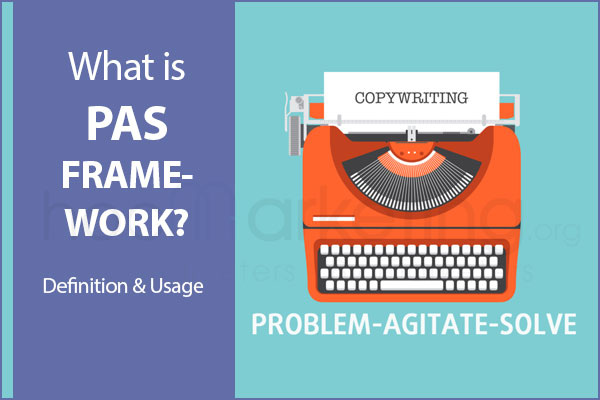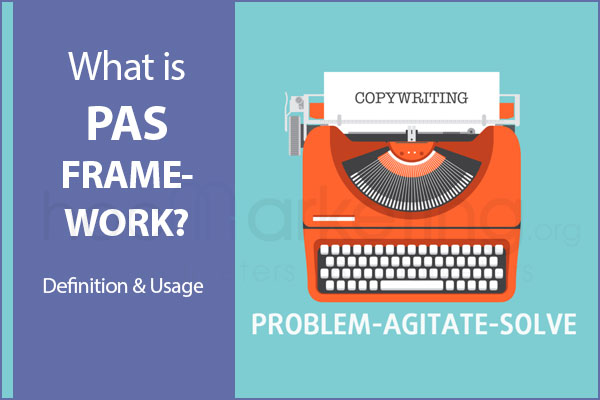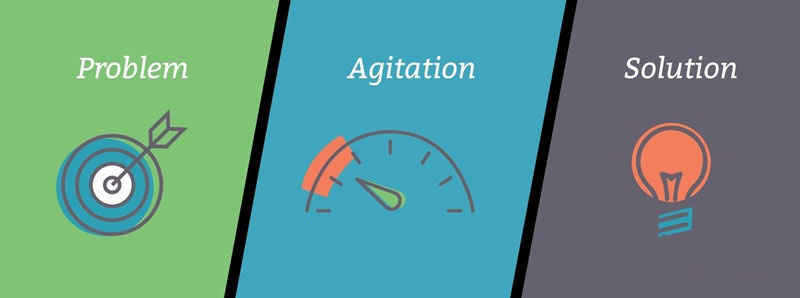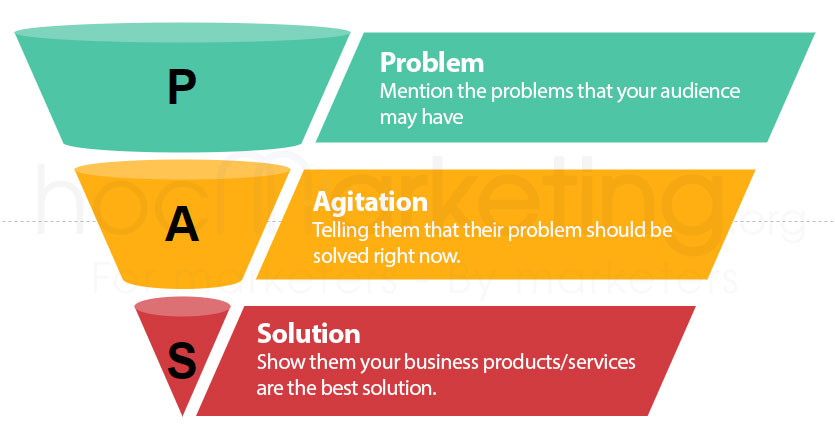
What is PAS? How to use PAS framework (model) in Copywriting?

The PAS framework is a popular model in copywriting that helps you understand how each part of the message affects the reader. This article will provide you a quick introduction to this framework (model).
Do you want to improve your copywriting skills, but don't know where to start? It's based on the idea that people respond to different messages in different ways and it will allow you to tailor your message depending on what type of person you're talking to. In copywriting, an article that really touches the customer's emotions is a quality outline-based article. That's why you need content creation formulas. However, to apply the formula effectively, you must have a clear understanding of the implementation steps and the suitability of the formula for the communication goals. This article will provide you with information about PAS - a simple formula that is easy to understand and is favored by many copywriters. So what is the PAS formula? What should copywriters pay attention to when applying the PAS formula? Let's find out with hocmarketing.org in this article!
What is PAS Framework (Model)?
PAS is a formula for creating content (content) in copywriting, making articles highly persuasive, hitting customers' minds and demonstrating the optimal solutions that brands bring. With content orientation based on understanding the psychology and concerns of customers, the PAS formula will help you easily attract the right customers and create a high conversion effect. The PAS acronym stands for:
- Problem (first part): What is the problem that you are addressing?
- Agitation (second part): How does this affect them? What's the worst thing that could happen if they don't act now?
- Solution (third part): What's your solution? How will it benefit them to act now?
For example, if you are selling a solution to make people's lives easier, the first part might be "They have too much work to do". The second part could be something like "They'll never finish all their chores before dinner" and the third part is "With our product, they can just relax after meal".
Short history of PAS Framework (Model)
PAS is a recipe created by advertising guru Dan Kennedy. This is also the formula for writing content (content) that made his name.
Dan Kennedy - Creator of AIDA
According to Dan Kennedy, this is the most wonderful of all the formulas he created. He once asserted, “When you understand that people tend to avoid pain rather than endure pain, you will see how this formula works.” Not only is it streamlined, easy to understand, and easy to apply to different advertising contents, but the PAS formula also ensures to reach the right customer psychology and is highly effective in promoting customer behavior. Therefore, PAS has become a classic formula applied by many copywriters for content such as social media, content ads, websites, email marketing, blogs...
How to use PAS framework (model) in copywriting
Using PAS framework (model) in copywriting is quite easy. You just have to divide your writing into 3 sections as the model says:
1. Problem
In the first section, you should directly mention the problems that readers might have. You can give them reassurance that you are aware of their problem and you know how to solve it.
In advertising, you only have 3 seconds to impress the viewer/reader, thereby increasing the percentage of them continuing to learn or listen to the message you are conveying. To be successful in that 3s decision, you need to really understand who your target audience is, what their "pain" is. If they buy your product/service, what will they be most interested in?
So at this step, you have to make sure that you don't make subjective assumptions about what problems the customer is having. Instead, study the market thoroughly and draw a customer persona by some methods such as observation (observation), interview, survey,... Especially, let's coordinate Together with other departments that have contact with customers (such as customer care department, Sales department) to collect the most truthful information and capture the most accurate customer psychology.
After you have obtained the necessary information about the potential customer, put yourself in their place and make all the words, feelings (tone and mood) in the article become the same as the customer expressed in the article. life. This will help you create a feeling of closeness with the customer and make them feel like you are talking about your "pain". From there, they will stop and continue to follow your ad to find the answer to the problem they want to solve.
A small note at this step is: The advertisement does not need to provide too much information about the problem that the customer is facing.
2. Agitation
The second part is about creating friction, which means you should mention the negative aspects of not solving this problem or investing in your product/service (or at least don't promise anything). Then after that, remind them of the first part and provide a solution to their problem.
Here are a few suggestions you can use:
- Indicate what the worst consequences will be if their problem is left unresolved: Help your client visualize the story of the consequences by adding visual elements to your ad, color, size.
- Show a negative effect on a problem the customer is having but rarely realizes: Draw a picture of the regrets and frustrations that the problem is causing to motivate the customer to want to solve it. quicken their "pain".
Point out the positive when they solve the problem: Paint a good future that satisfies the customer's desire. - Affirm your suitability for customers: Letting your customers know that you are the most suitable out of the many options, can help them get rid of all worries in the fastest and most economical way.
- Show urgency: Stimulate the feeling of “pain, discomfort” created by the problem and make the customer yearn for a quick resolution.
3. Solution
The third part is where you tell your customer that you have all the answers they are looking for. You should mention how your product or service will fix their problem and how they can get it.
Here are a few ways to make a good Solution:
- Tell directly about the outstanding benefits of the product/service to help solve the customer's problem. However, you should not "show off" all the values and features of your product/service, but choose what customers want to hear and feel.
- Choose a solution that's personalized to your target audience. Customers just want to know how to handle their own problems, not someone else's. So, refine and personalize the solution to ensure customer retention.
- Concretize the effectiveness of the solution by: reviews from old customers, data... to increase your transparency and trustworthiness.
Please note that when introducing the solution to customers, you still have to ensure the transparency of the value you bring and incorporate the CTA (call-to-action) to increase the conversion rate for the ad.
The advantages of PAS
1. High persuasion
According to Copyblogger, the PAS formula “makes the advertisement coherent, clear and convincing”. When you apply the formula, you will create an article with a clear direction, the story you tell has its own order and purpose. Besides, you will take the initiative to guide customers' psychology and emotions to encourage them to perform the behavior you want.
2. Dễ nhận được sự quan tâm
In the book "80/20 Sales and Marketing", Mr. Perry Marshall, an American business consultant, once asserted that a message about the problem can attract 3 to 10 times more interaction than the story about the company. or product. Therefore, when you apply the PAS formula, you are eliciting customer behavior from facts and problems in their own lives. Your ad also becomes a story from the client's diary. That's why PAS is such a classic formula in copywriting.
3. PAS writings are often easy to understand
First of all, this model is based on psychology which makes it very easy to understand. You can quickly adjust your message or ads according to people's level of motivation. That means you will be able to increase your conversion rates.
4. PAS framework (model) is very versatile
The PAS framework is very versatile, you can use it in both online marketing and offline. You can also apply it to advertisements, videos or articles/blogs, by including different parts of the framework depending on what you are talking about.
5. PAS Framework (model) is measurable
You can measure the effectiveness of each part of the PAS framework. For example, you can see how many people read your title or watched your ad so you know which parts were more effective than others. Using these insights, you can optimize future campaigns by making them more engaging for your target audience.
The disadvantages of PAS
1. PAS requires concentration
You need to focus on the deciding factors, the salient features (USPs) of the product/service to avoid falling behind, list a lot of information that makes the article less coherent in order to make a good PAS copy.
2. PAS requires brevity
Because the goal of the PAS formula is to "beat quickly, win quickly", capture the customer's psychology and constantly urge them to buy products/services, so the content you write needs to be concise, maintaining an urgent context. Thus, the effectiveness of promoting new customers is improved.
3. Transparency needs to be ensured
Any advertisement needs to show the optimal benefits and value of the brand for the user. However, with the "push" feature of the PAS formula, the writer has to both refine the good points of the product/service that is suitable for the customer, while also paying attention to properly represent the values he brings. If it falls into the case of "overstatement", it will backfire on the article and create a negative effect when customers give feedback on the product/service.
4. Not all people are effected by emotions
Even though Daniel Starch's study showed that most people are emotionally driven, some people don't care about the negative aspects of their problem. This means they won't act even if you talk to them about how bad it is not solving their problems or making a purchase.
5. PAS Framework (model) is not 100% accurate
I mentioned before that you have to personalize your copy for each target audience. People are motivated by different things, what might work for one group of people might not work for another. You also can't use this framework on all products/services you are selling because some of them are more emotional than rational.
6. Not everyone has problems
There are some people that don't have any problems, which means they won't need your products or services. In these cases, PAS framework can be a bad fit because you will spend time and money on marketing messages that don't work for them.
Conclusion
The PAS Framework (Model) is a perfect fit for marketers who want to create effective messages that resonate with their customers. This model provides an easy-to-follow structure for creating copywriting, which can be modified depending on what you're selling and your target audience's motivation level. However, the framework also has it own limits which should be considered when using. I hope this article was useful for you. And remember that the model cannot cover bad writing skills, therefore, you shou keep learning and practicing everyday!



















